Feasibility of Expanding Coles Bakery Products to China and Singapore
VerifiedAdded on 2023/01/19
|9
|1725
|45
AI Summary
This article explores the feasibility of expanding Coles bakery products to the international markets of China and Singapore. It analyzes the economic indicators of both countries, such as GDP, inflation rate, interest rates, education levels, and employment rates, to determine the suitability of each market. Based on the analysis, Singapore is found to be a more attractive destination for Coles to expand its bakery business.
Contribute Materials
Your contribution can guide someone’s learning journey. Share your
documents today.
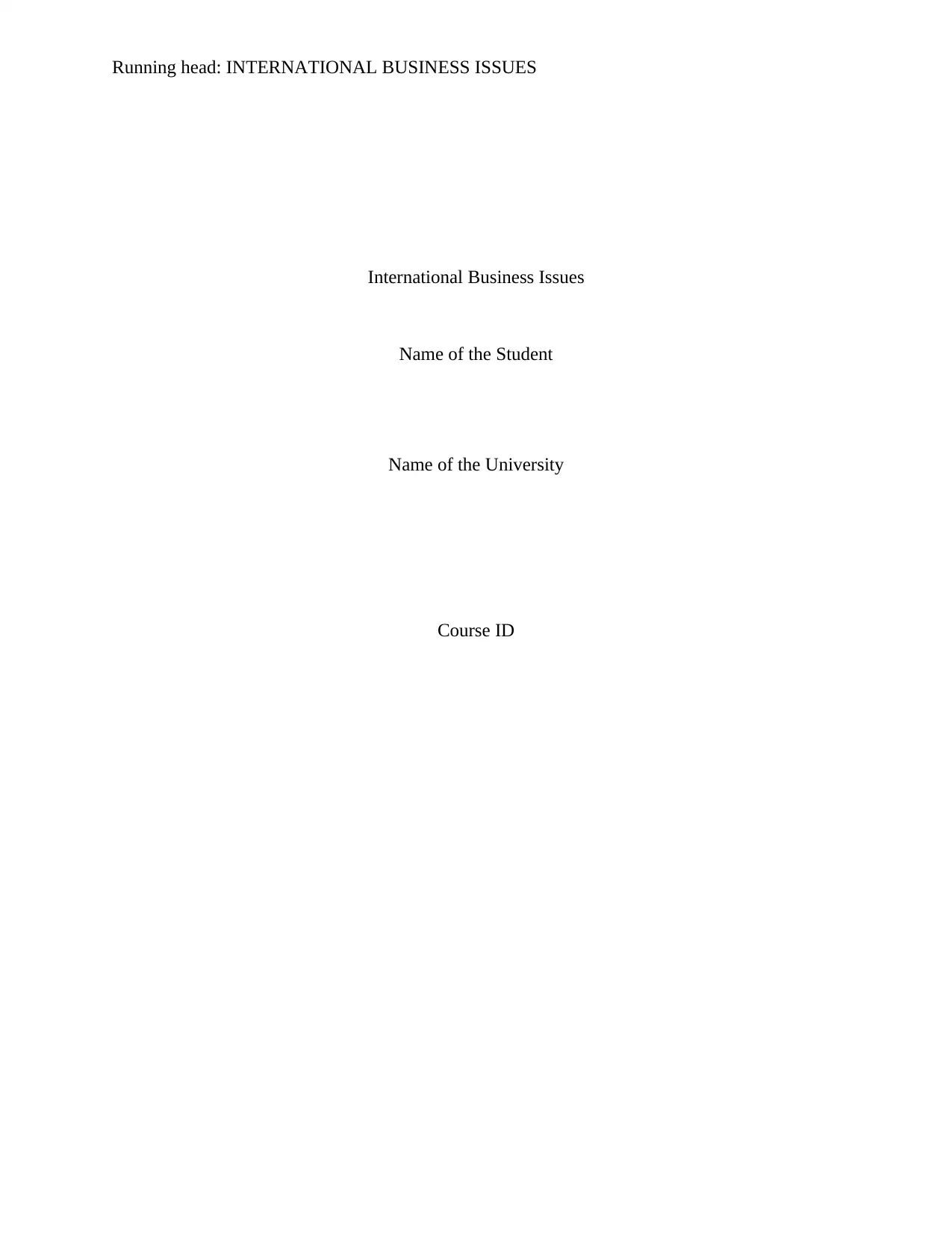
Running head: INTERNATIONAL BUSINESS ISSUES
International Business Issues
Name of the Student
Name of the University
Course ID
International Business Issues
Name of the Student
Name of the University
Course ID
Secure Best Marks with AI Grader
Need help grading? Try our AI Grader for instant feedback on your assignments.

1INTERNATIONAL BUSINESS ISSUES
Table of Contents
Introduction......................................................................................................................................2
Product to be introduced to the international market.......................................................................2
Background of the economy of China and Singapore.....................................................................2
Economic indicators of China.........................................................................................................3
Gross Domestic Product..............................................................................................................3
Inflation rate.................................................................................................................................3
Education levels and labor force skills available.........................................................................3
Current interest rates....................................................................................................................4
Current value of local currency against United State dollar........................................................4
Employment rate..........................................................................................................................4
Average income...........................................................................................................................4
Economic indicators of Singapore...................................................................................................4
Gross Domestic Product..............................................................................................................4
Inflation rate.................................................................................................................................5
Education levels and labor force skills available.........................................................................5
Current interest rates....................................................................................................................5
Current value of local currency against United State dollar........................................................5
Employment rate..........................................................................................................................5
Average income...........................................................................................................................5
Feasibility of doing business in the international market................................................................5
Recommendation and conclusion....................................................................................................6
References........................................................................................................................................7
Table of Contents
Introduction......................................................................................................................................2
Product to be introduced to the international market.......................................................................2
Background of the economy of China and Singapore.....................................................................2
Economic indicators of China.........................................................................................................3
Gross Domestic Product..............................................................................................................3
Inflation rate.................................................................................................................................3
Education levels and labor force skills available.........................................................................3
Current interest rates....................................................................................................................4
Current value of local currency against United State dollar........................................................4
Employment rate..........................................................................................................................4
Average income...........................................................................................................................4
Economic indicators of Singapore...................................................................................................4
Gross Domestic Product..............................................................................................................4
Inflation rate.................................................................................................................................5
Education levels and labor force skills available.........................................................................5
Current interest rates....................................................................................................................5
Current value of local currency against United State dollar........................................................5
Employment rate..........................................................................................................................5
Average income...........................................................................................................................5
Feasibility of doing business in the international market................................................................5
Recommendation and conclusion....................................................................................................6
References........................................................................................................................................7
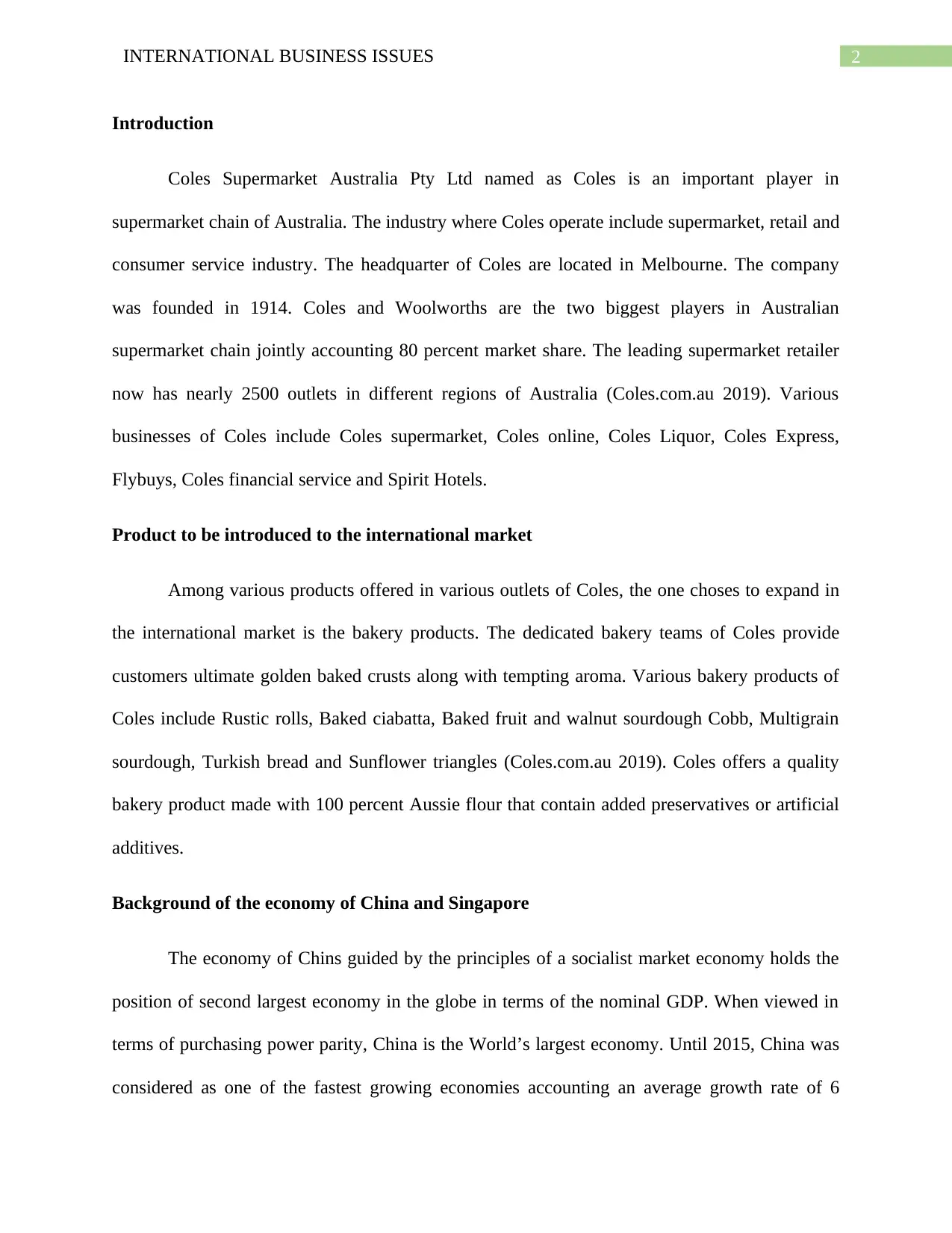
2INTERNATIONAL BUSINESS ISSUES
Introduction
Coles Supermarket Australia Pty Ltd named as Coles is an important player in
supermarket chain of Australia. The industry where Coles operate include supermarket, retail and
consumer service industry. The headquarter of Coles are located in Melbourne. The company
was founded in 1914. Coles and Woolworths are the two biggest players in Australian
supermarket chain jointly accounting 80 percent market share. The leading supermarket retailer
now has nearly 2500 outlets in different regions of Australia (Coles.com.au 2019). Various
businesses of Coles include Coles supermarket, Coles online, Coles Liquor, Coles Express,
Flybuys, Coles financial service and Spirit Hotels.
Product to be introduced to the international market
Among various products offered in various outlets of Coles, the one choses to expand in
the international market is the bakery products. The dedicated bakery teams of Coles provide
customers ultimate golden baked crusts along with tempting aroma. Various bakery products of
Coles include Rustic rolls, Baked ciabatta, Baked fruit and walnut sourdough Cobb, Multigrain
sourdough, Turkish bread and Sunflower triangles (Coles.com.au 2019). Coles offers a quality
bakery product made with 100 percent Aussie flour that contain added preservatives or artificial
additives.
Background of the economy of China and Singapore
The economy of Chins guided by the principles of a socialist market economy holds the
position of second largest economy in the globe in terms of the nominal GDP. When viewed in
terms of purchasing power parity, China is the World’s largest economy. Until 2015, China was
considered as one of the fastest growing economies accounting an average growth rate of 6
Introduction
Coles Supermarket Australia Pty Ltd named as Coles is an important player in
supermarket chain of Australia. The industry where Coles operate include supermarket, retail and
consumer service industry. The headquarter of Coles are located in Melbourne. The company
was founded in 1914. Coles and Woolworths are the two biggest players in Australian
supermarket chain jointly accounting 80 percent market share. The leading supermarket retailer
now has nearly 2500 outlets in different regions of Australia (Coles.com.au 2019). Various
businesses of Coles include Coles supermarket, Coles online, Coles Liquor, Coles Express,
Flybuys, Coles financial service and Spirit Hotels.
Product to be introduced to the international market
Among various products offered in various outlets of Coles, the one choses to expand in
the international market is the bakery products. The dedicated bakery teams of Coles provide
customers ultimate golden baked crusts along with tempting aroma. Various bakery products of
Coles include Rustic rolls, Baked ciabatta, Baked fruit and walnut sourdough Cobb, Multigrain
sourdough, Turkish bread and Sunflower triangles (Coles.com.au 2019). Coles offers a quality
bakery product made with 100 percent Aussie flour that contain added preservatives or artificial
additives.
Background of the economy of China and Singapore
The economy of Chins guided by the principles of a socialist market economy holds the
position of second largest economy in the globe in terms of the nominal GDP. When viewed in
terms of purchasing power parity, China is the World’s largest economy. Until 2015, China was
considered as one of the fastest growing economies accounting an average growth rate of 6
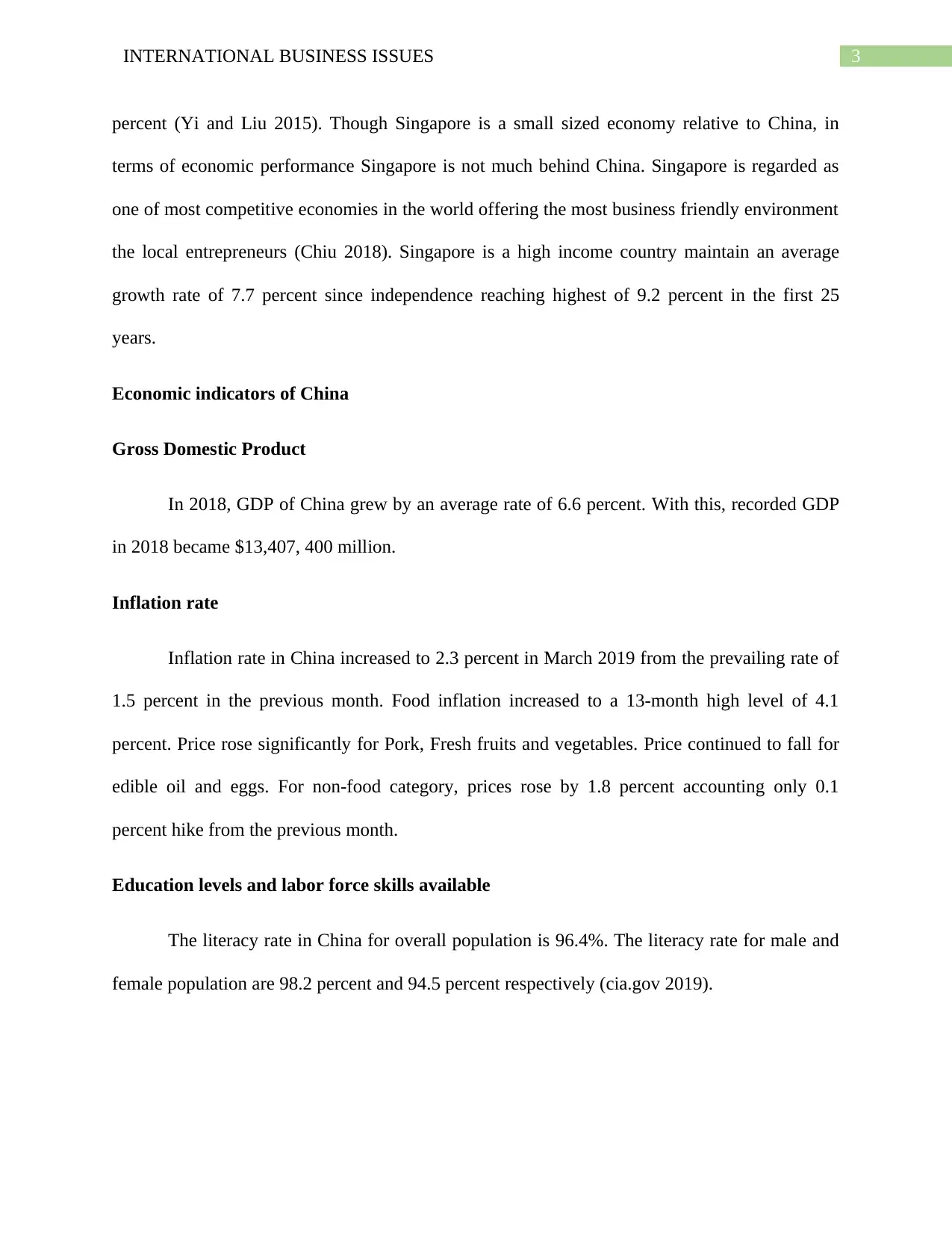
3INTERNATIONAL BUSINESS ISSUES
percent (Yi and Liu 2015). Though Singapore is a small sized economy relative to China, in
terms of economic performance Singapore is not much behind China. Singapore is regarded as
one of most competitive economies in the world offering the most business friendly environment
the local entrepreneurs (Chiu 2018). Singapore is a high income country maintain an average
growth rate of 7.7 percent since independence reaching highest of 9.2 percent in the first 25
years.
Economic indicators of China
Gross Domestic Product
In 2018, GDP of China grew by an average rate of 6.6 percent. With this, recorded GDP
in 2018 became $13,407, 400 million.
Inflation rate
Inflation rate in China increased to 2.3 percent in March 2019 from the prevailing rate of
1.5 percent in the previous month. Food inflation increased to a 13-month high level of 4.1
percent. Price rose significantly for Pork, Fresh fruits and vegetables. Price continued to fall for
edible oil and eggs. For non-food category, prices rose by 1.8 percent accounting only 0.1
percent hike from the previous month.
Education levels and labor force skills available
The literacy rate in China for overall population is 96.4%. The literacy rate for male and
female population are 98.2 percent and 94.5 percent respectively (cia.gov 2019).
percent (Yi and Liu 2015). Though Singapore is a small sized economy relative to China, in
terms of economic performance Singapore is not much behind China. Singapore is regarded as
one of most competitive economies in the world offering the most business friendly environment
the local entrepreneurs (Chiu 2018). Singapore is a high income country maintain an average
growth rate of 7.7 percent since independence reaching highest of 9.2 percent in the first 25
years.
Economic indicators of China
Gross Domestic Product
In 2018, GDP of China grew by an average rate of 6.6 percent. With this, recorded GDP
in 2018 became $13,407, 400 million.
Inflation rate
Inflation rate in China increased to 2.3 percent in March 2019 from the prevailing rate of
1.5 percent in the previous month. Food inflation increased to a 13-month high level of 4.1
percent. Price rose significantly for Pork, Fresh fruits and vegetables. Price continued to fall for
edible oil and eggs. For non-food category, prices rose by 1.8 percent accounting only 0.1
percent hike from the previous month.
Education levels and labor force skills available
The literacy rate in China for overall population is 96.4%. The literacy rate for male and
female population are 98.2 percent and 94.5 percent respectively (cia.gov 2019).
Secure Best Marks with AI Grader
Need help grading? Try our AI Grader for instant feedback on your assignments.
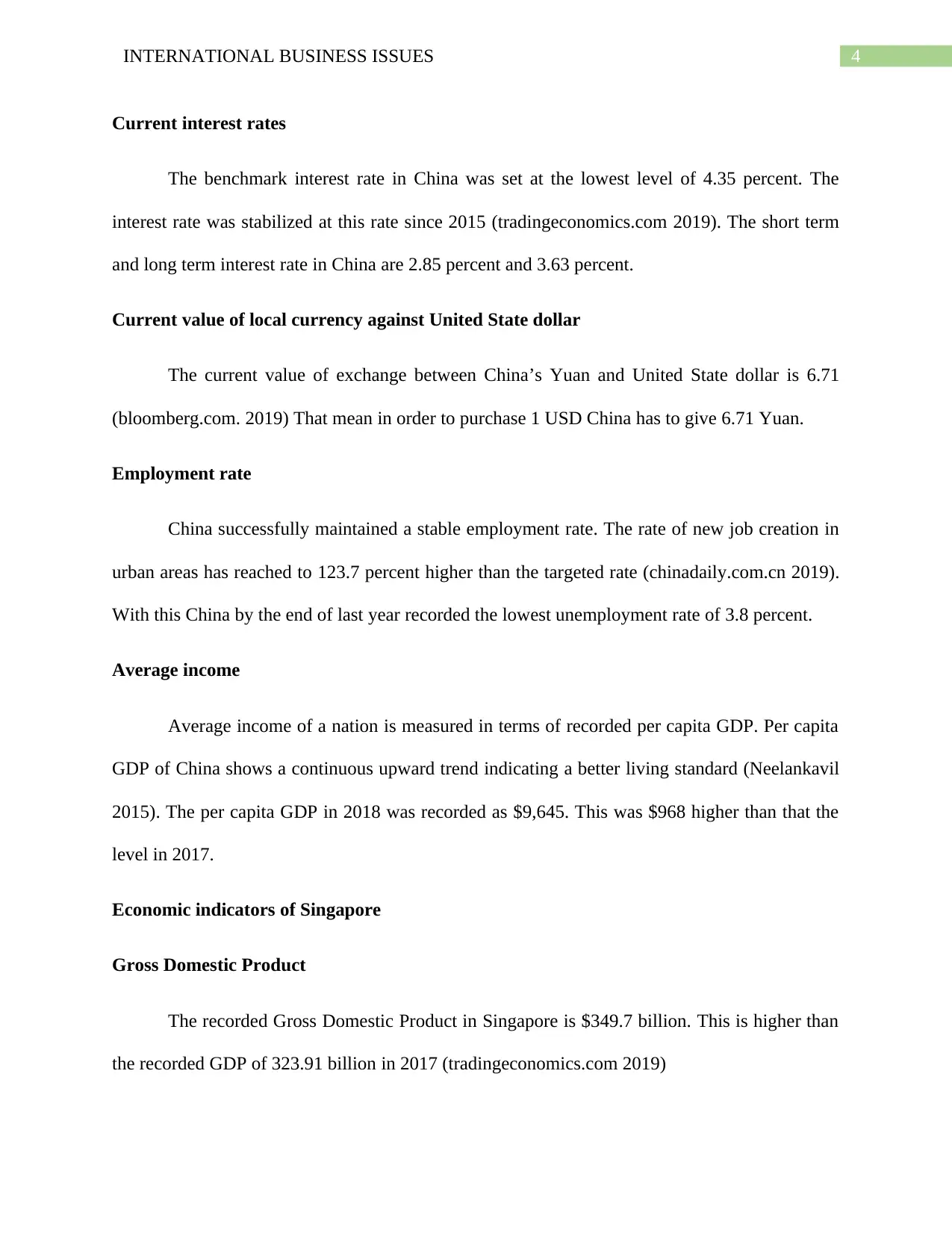
4INTERNATIONAL BUSINESS ISSUES
Current interest rates
The benchmark interest rate in China was set at the lowest level of 4.35 percent. The
interest rate was stabilized at this rate since 2015 (tradingeconomics.com 2019). The short term
and long term interest rate in China are 2.85 percent and 3.63 percent.
Current value of local currency against United State dollar
The current value of exchange between China’s Yuan and United State dollar is 6.71
(bloomberg.com. 2019) That mean in order to purchase 1 USD China has to give 6.71 Yuan.
Employment rate
China successfully maintained a stable employment rate. The rate of new job creation in
urban areas has reached to 123.7 percent higher than the targeted rate (chinadaily.com.cn 2019).
With this China by the end of last year recorded the lowest unemployment rate of 3.8 percent.
Average income
Average income of a nation is measured in terms of recorded per capita GDP. Per capita
GDP of China shows a continuous upward trend indicating a better living standard (Neelankavil
2015). The per capita GDP in 2018 was recorded as $9,645. This was $968 higher than that the
level in 2017.
Economic indicators of Singapore
Gross Domestic Product
The recorded Gross Domestic Product in Singapore is $349.7 billion. This is higher than
the recorded GDP of 323.91 billion in 2017 (tradingeconomics.com 2019)
Current interest rates
The benchmark interest rate in China was set at the lowest level of 4.35 percent. The
interest rate was stabilized at this rate since 2015 (tradingeconomics.com 2019). The short term
and long term interest rate in China are 2.85 percent and 3.63 percent.
Current value of local currency against United State dollar
The current value of exchange between China’s Yuan and United State dollar is 6.71
(bloomberg.com. 2019) That mean in order to purchase 1 USD China has to give 6.71 Yuan.
Employment rate
China successfully maintained a stable employment rate. The rate of new job creation in
urban areas has reached to 123.7 percent higher than the targeted rate (chinadaily.com.cn 2019).
With this China by the end of last year recorded the lowest unemployment rate of 3.8 percent.
Average income
Average income of a nation is measured in terms of recorded per capita GDP. Per capita
GDP of China shows a continuous upward trend indicating a better living standard (Neelankavil
2015). The per capita GDP in 2018 was recorded as $9,645. This was $968 higher than that the
level in 2017.
Economic indicators of Singapore
Gross Domestic Product
The recorded Gross Domestic Product in Singapore is $349.7 billion. This is higher than
the recorded GDP of 323.91 billion in 2017 (tradingeconomics.com 2019)
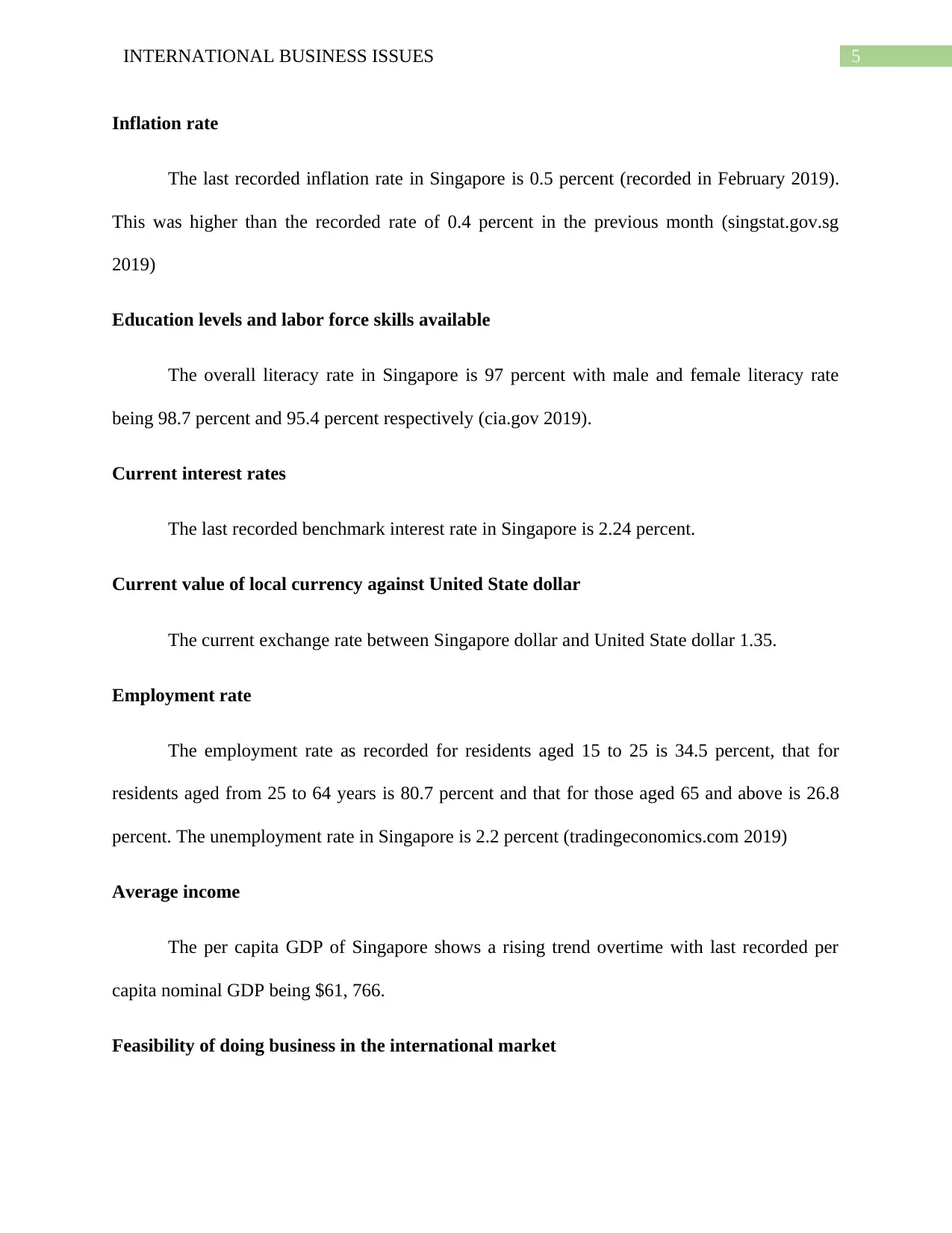
5INTERNATIONAL BUSINESS ISSUES
Inflation rate
The last recorded inflation rate in Singapore is 0.5 percent (recorded in February 2019).
This was higher than the recorded rate of 0.4 percent in the previous month (singstat.gov.sg
2019)
Education levels and labor force skills available
The overall literacy rate in Singapore is 97 percent with male and female literacy rate
being 98.7 percent and 95.4 percent respectively (cia.gov 2019).
Current interest rates
The last recorded benchmark interest rate in Singapore is 2.24 percent.
Current value of local currency against United State dollar
The current exchange rate between Singapore dollar and United State dollar 1.35.
Employment rate
The employment rate as recorded for residents aged 15 to 25 is 34.5 percent, that for
residents aged from 25 to 64 years is 80.7 percent and that for those aged 65 and above is 26.8
percent. The unemployment rate in Singapore is 2.2 percent (tradingeconomics.com 2019)
Average income
The per capita GDP of Singapore shows a rising trend overtime with last recorded per
capita nominal GDP being $61, 766.
Feasibility of doing business in the international market
Inflation rate
The last recorded inflation rate in Singapore is 0.5 percent (recorded in February 2019).
This was higher than the recorded rate of 0.4 percent in the previous month (singstat.gov.sg
2019)
Education levels and labor force skills available
The overall literacy rate in Singapore is 97 percent with male and female literacy rate
being 98.7 percent and 95.4 percent respectively (cia.gov 2019).
Current interest rates
The last recorded benchmark interest rate in Singapore is 2.24 percent.
Current value of local currency against United State dollar
The current exchange rate between Singapore dollar and United State dollar 1.35.
Employment rate
The employment rate as recorded for residents aged 15 to 25 is 34.5 percent, that for
residents aged from 25 to 64 years is 80.7 percent and that for those aged 65 and above is 26.8
percent. The unemployment rate in Singapore is 2.2 percent (tradingeconomics.com 2019)
Average income
The per capita GDP of Singapore shows a rising trend overtime with last recorded per
capita nominal GDP being $61, 766.
Feasibility of doing business in the international market

6INTERNATIONAL BUSINESS ISSUES
Expanding business to an international market depends on the economic environment of
the chosen destination (Hamilton and Webster 2018). Different indicators used to evaluate
economic environment of a nation include GDP, inflation, interest rate, education level,
exchange rate, unemployment rate and average income (Morschett, Schramm-Klein and Zentes
2015). Gross Domestic product of a nation is a measure of aggregate economic output. China
though has a much larger GDP than Singapore per capita GDP is higher in Singapore. This is
because of larger size of population in China. Unemployment rate, interest rate and inflation rate
in Singapore are lower than that in China. The value of domestic currency of Singapore as
against USD is greater compare to value of China’s Yuan against USD. This indicates a
relatively strong international position of Singapore (Meyer and Peng 2016).
Recommendation and conclusion
The comparative analysis of economic environment of China and Singapore suggests that
Singapore is a more attractive destination for “Coles” to expand business to the Asian market.
The higher average income, lower interest rate, lower unemployment rate, higher literacy, a
stronger international position and business friendly environment of Singapore makes it a more
suitable place for business expansion.
Expanding business to an international market depends on the economic environment of
the chosen destination (Hamilton and Webster 2018). Different indicators used to evaluate
economic environment of a nation include GDP, inflation, interest rate, education level,
exchange rate, unemployment rate and average income (Morschett, Schramm-Klein and Zentes
2015). Gross Domestic product of a nation is a measure of aggregate economic output. China
though has a much larger GDP than Singapore per capita GDP is higher in Singapore. This is
because of larger size of population in China. Unemployment rate, interest rate and inflation rate
in Singapore are lower than that in China. The value of domestic currency of Singapore as
against USD is greater compare to value of China’s Yuan against USD. This indicates a
relatively strong international position of Singapore (Meyer and Peng 2016).
Recommendation and conclusion
The comparative analysis of economic environment of China and Singapore suggests that
Singapore is a more attractive destination for “Coles” to expand business to the Asian market.
The higher average income, lower interest rate, lower unemployment rate, higher literacy, a
stronger international position and business friendly environment of Singapore makes it a more
suitable place for business expansion.
Paraphrase This Document
Need a fresh take? Get an instant paraphrase of this document with our AI Paraphraser

7INTERNATIONAL BUSINESS ISSUES
References
bloomberg.com 2019. Bloomberg [online] Bloomberg.com. Available at:
https://www.bloomberg.com/quote/USDSGD:CUR [Accessed 16 Apr. 2019].
chinadaily.com.cn 2019. Employment rate remains steady in China - Chinadaily.com.cn. [online]
Chinadaily.com.cn. Available at:
http://www.chinadaily.com.cn/a/201902/25/WS5c738815a3106c65c34eb420.html [Accessed 16
Apr. 2019].
Chiu, S.W.K., 2018. City states in the global economy: Industrial restructuring in Hong Kong
and Singapore. Routledge.
cia.gov 2019. East Asia/Southeast Asia :: China — The World Factbook - Central Intelligence
Agency. [online] Cia.gov. Available at: https://www.cia.gov/library/publications/resources/the-
world-factbook/geos/ch.html [Accessed 16 Apr. 2019].
Coles.com.au 2019. Coles Supermarkets. [online] Coles.com.au. Available at:
https://www.coles.com.au/ [Accessed 16 Apr. 2019].
Hamilton, L. and Webster, P., 2018. The international business environment. Oxford University
Press.
Meyer, K. and Peng, M.W., 2016. International business. Cengage Learning.
Morschett, D., Schramm-Klein, H. and Zentes, J., 2015. Strategic international management (pp.
978-3658078836). Springer.
Neelankavil, J.P., 2015. International business research. Routledge.
References
bloomberg.com 2019. Bloomberg [online] Bloomberg.com. Available at:
https://www.bloomberg.com/quote/USDSGD:CUR [Accessed 16 Apr. 2019].
chinadaily.com.cn 2019. Employment rate remains steady in China - Chinadaily.com.cn. [online]
Chinadaily.com.cn. Available at:
http://www.chinadaily.com.cn/a/201902/25/WS5c738815a3106c65c34eb420.html [Accessed 16
Apr. 2019].
Chiu, S.W.K., 2018. City states in the global economy: Industrial restructuring in Hong Kong
and Singapore. Routledge.
cia.gov 2019. East Asia/Southeast Asia :: China — The World Factbook - Central Intelligence
Agency. [online] Cia.gov. Available at: https://www.cia.gov/library/publications/resources/the-
world-factbook/geos/ch.html [Accessed 16 Apr. 2019].
Coles.com.au 2019. Coles Supermarkets. [online] Coles.com.au. Available at:
https://www.coles.com.au/ [Accessed 16 Apr. 2019].
Hamilton, L. and Webster, P., 2018. The international business environment. Oxford University
Press.
Meyer, K. and Peng, M.W., 2016. International business. Cengage Learning.
Morschett, D., Schramm-Klein, H. and Zentes, J., 2015. Strategic international management (pp.
978-3658078836). Springer.
Neelankavil, J.P., 2015. International business research. Routledge.
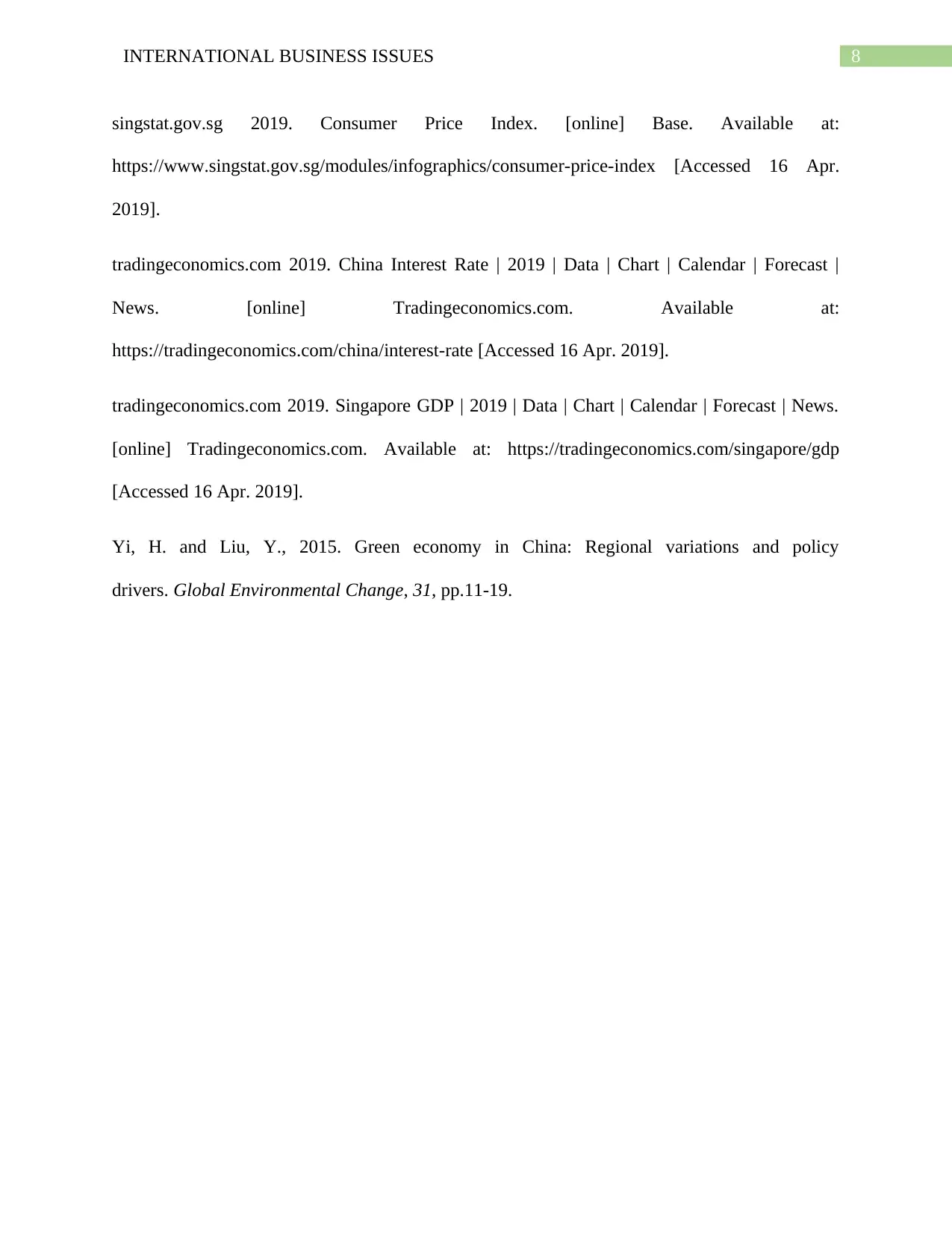
8INTERNATIONAL BUSINESS ISSUES
singstat.gov.sg 2019. Consumer Price Index. [online] Base. Available at:
https://www.singstat.gov.sg/modules/infographics/consumer-price-index [Accessed 16 Apr.
2019].
tradingeconomics.com 2019. China Interest Rate | 2019 | Data | Chart | Calendar | Forecast |
News. [online] Tradingeconomics.com. Available at:
https://tradingeconomics.com/china/interest-rate [Accessed 16 Apr. 2019].
tradingeconomics.com 2019. Singapore GDP | 2019 | Data | Chart | Calendar | Forecast | News.
[online] Tradingeconomics.com. Available at: https://tradingeconomics.com/singapore/gdp
[Accessed 16 Apr. 2019].
Yi, H. and Liu, Y., 2015. Green economy in China: Regional variations and policy
drivers. Global Environmental Change, 31, pp.11-19.
singstat.gov.sg 2019. Consumer Price Index. [online] Base. Available at:
https://www.singstat.gov.sg/modules/infographics/consumer-price-index [Accessed 16 Apr.
2019].
tradingeconomics.com 2019. China Interest Rate | 2019 | Data | Chart | Calendar | Forecast |
News. [online] Tradingeconomics.com. Available at:
https://tradingeconomics.com/china/interest-rate [Accessed 16 Apr. 2019].
tradingeconomics.com 2019. Singapore GDP | 2019 | Data | Chart | Calendar | Forecast | News.
[online] Tradingeconomics.com. Available at: https://tradingeconomics.com/singapore/gdp
[Accessed 16 Apr. 2019].
Yi, H. and Liu, Y., 2015. Green economy in China: Regional variations and policy
drivers. Global Environmental Change, 31, pp.11-19.
1 out of 9
Related Documents
Your All-in-One AI-Powered Toolkit for Academic Success.
+13062052269
info@desklib.com
Available 24*7 on WhatsApp / Email
![[object Object]](/_next/static/media/star-bottom.7253800d.svg)
Unlock your academic potential
© 2024 | Zucol Services PVT LTD | All rights reserved.




